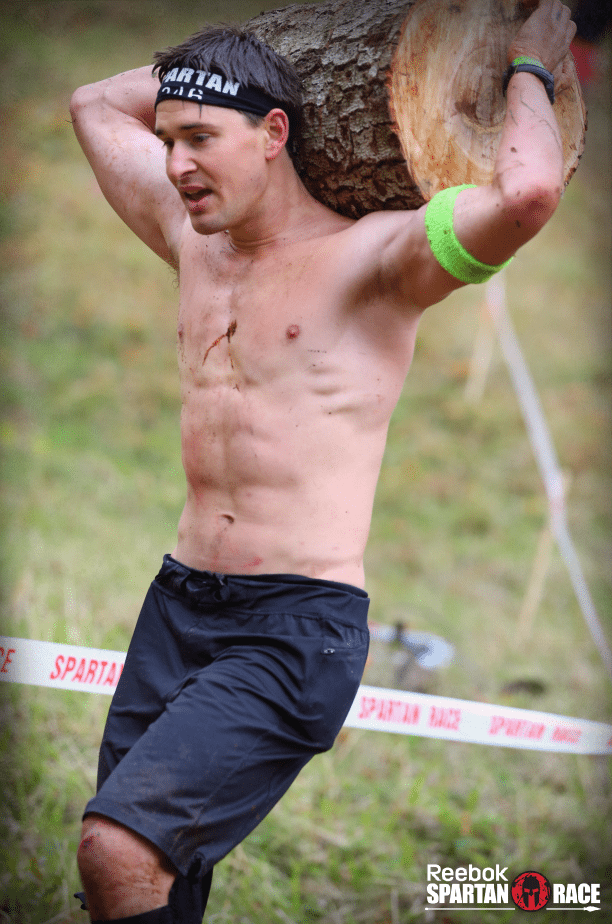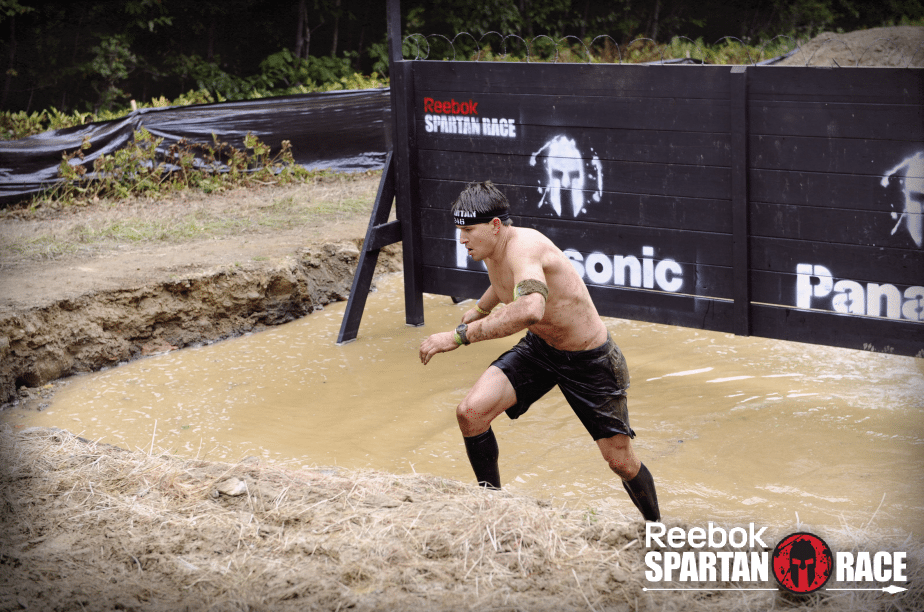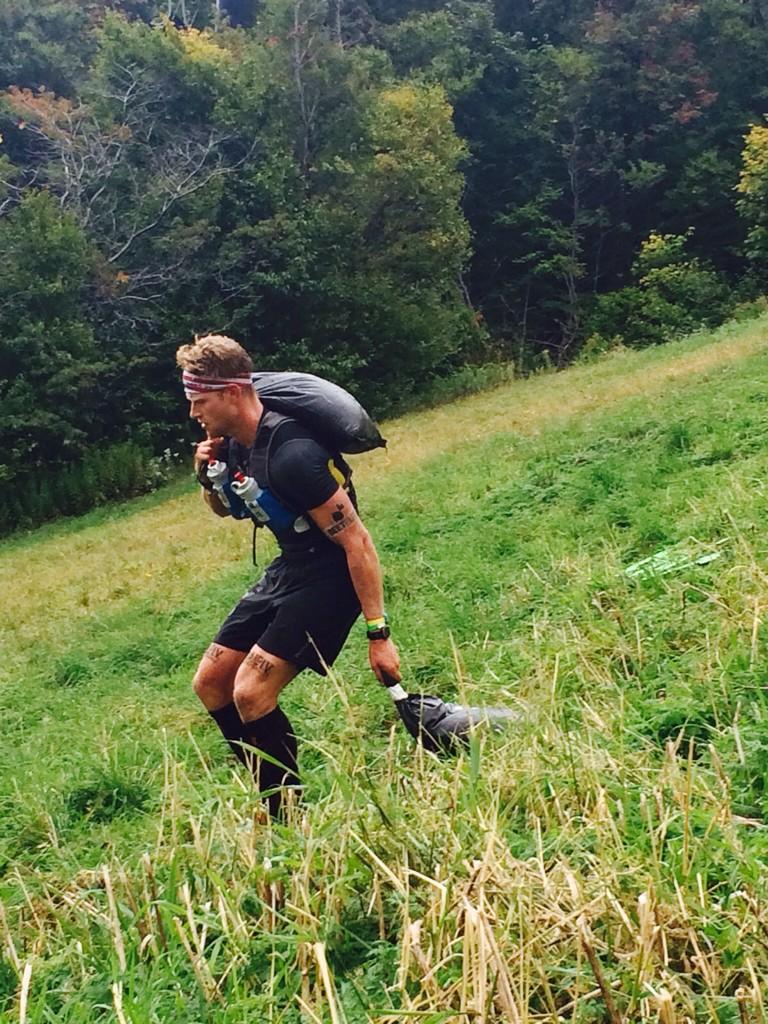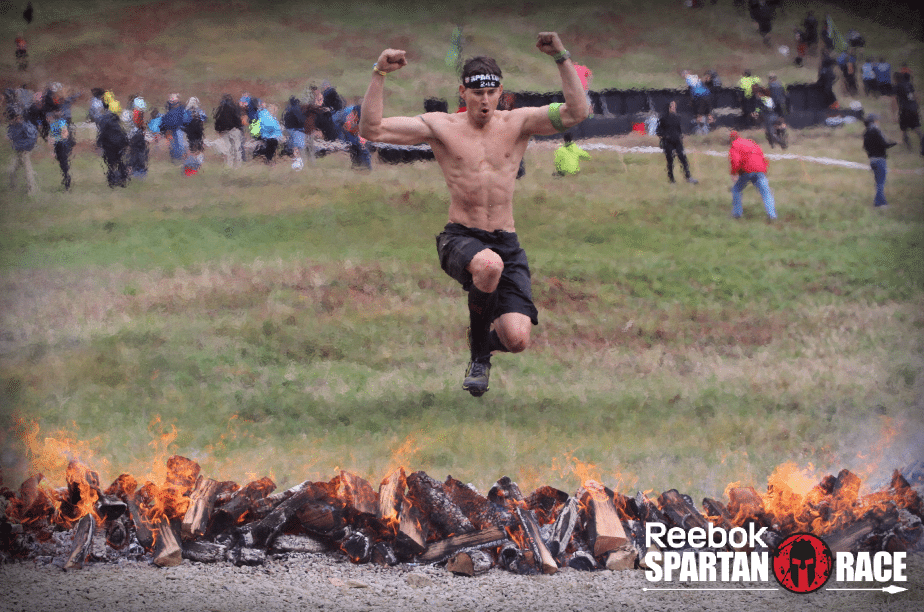September 25, 2014
As I mentioned I'd be doing a couple weeks ago when I gave you the Top 10 Workouts of 2014, I just finished the brutal Vermont Spartan Beast in the Green Mountains of New England. This race is considered to be the “Super Bowl” of obstacle racing and the official World Championships of Spartan, in which the best of the best obstacle racers from around the world come to throw down the gauntlet.
Knees throbbing?
Check.
Quads trashed?
Check.
Plenty of lessons learned?
Check.
So in today's post, I'll pass those valuable lessons on to you. You're going to get 10 tips to race a Spartan Beast – and even if you don't plan on ever doing this race, these tips will be extremely valuable for you in any long, hilly running event.
Let's begin…
1. Learn How To Run Downhill
I worked my butt off in many sections of the steep Vermont Beast hills to pass other athletes, only to be frustratingly passed by those same athletes on the downhills – which I ran far too conservatively and obviously need to practice. It's no good having superior fitness if your competitors know how to move smart and use gravity to their advantage. I'd highly recommend you (as I am doing) study this downhill running article, which is pure gold when it comes to downhill running speed tips. Here are a few snippets from it:
“Next time you are slogging up Pikes Peak or Hope Pass and the Big Boys are coming back down, watch how they run. The first thing you will notice is that they are going REAL FAST, like 6-minute miles or better over really crappy terrain. The second thing you will notice is that they are not taking little short shuffling steps. They are bounding down the hill, hurdling rocks, logs, etc. On your next training run, try some strides at a sub-6 pace and look at how your feet are landing. I bet you will be landing on your toes.”
“On running wet trails I have found a few things. First, try to keep your center of gravity over your feet, which usually requires a shorter stride and less aggressive pace. It can look like a ‘shuffle' when done properly, but tends to prevent some of the slippage that an all-out stride would cause. On slippery downhills, more strides in less space generally equals more stability. If room allows, I also sometimes “tack” down slippery hills like a skier would a steep slope; rather than running straight down, I'll make zigs from side to side. This also takes advantage of the fact that the *side* of the trail is often less slippery than the center, where all the water tends to collect.”
“Practice makes perfect. We have a hill where I live that rises about 1400 feet in 2 miles. During good running weather a group of us do a training run once a week for about 2 hours, finishing with the 2-mile downhill and spending whatever we have left. Several runners were initially poor downhillers and have improved dramatically. Practice strengthens the quads to handle the work, improves technique, and builds confidence.”
“As far as technique is concerned, I'm not sure one size fits all. I have short legs, while some friends who initially were poor downhillers have long legs. How far forward you land on your foot depends on how steep the hill– the steeper the slope the further back on your foot you have to land. I try not to land on my heels, though, because that causes braking. I like having a lot of foot surface landing to improve traction. If the hill is smooth and not steep, landing near the front of the foot and sliding a little makes it easy on the quads.”
“Concentration is critical. I am a shuffler, so I have little ground clearance. If I'm not paying attention, I'll trip. You want to look ahead about 5 feet. I can only marvel at how the brain takes this information and transforms it into foot placements that work.”
“Attitude is important. Practice breeds confidence. Running lots of downhills in training–especially somewhat rocky ones–lets you know you can do it well. In long races I always try to stretch out a bit on downhills, relaxing but letting it flow. I expect to make up time on downhills, but I also want to feel I'll be able to run the next downhill well, and the next one. When I'm feeling good in a race, I try not to get greedy and spend it all–I'd rather feel like I'm making the good phase last as long as possible.”
Just in case you need more inspiration to learn how to run downhill, here are the scars that I racked up from not simply failing to run downhill fast, but also falling flat on my face in an all-out, embarrassing yard sale style fall at mile 3.



———————————–
2. Protect Your Knees and Ankles
You're going to be running down steep, slippery, rocky and obstacle strewn terrain. A lot. Despite having run multiple Ironman triathlons and marathons:
1) my knees are more trashed than they have been from any other event – partially from tripping and sliding nearly 10 feet downhill on my frontside, but also from the constant downhill pounding;
2) my ankles were more challenged than they ever have been, with multiple close calls with twists and sprains that would have resulted in long and painful limping the rest of the event.
For this reason, I think it's smart to tape the knees and tape the ankles using the kinesiotaping approach I discuss in this podcast. I'd recommend this full ankle stability taping method and this full knee support taping method. You can easily learn these taping methods yourself, and get KT Tape or Rock Tape on Amazon.
So why don't I recommend ankle braces or knee braces, rather than tape?
One big F word: Friction.
———————————–
3. Hydration Packs Are Optional
As you may have seen in my “Spartan Race Gear” video, I showed up on the starting line for the race wearing a simple, sling-across-the-waist style water bottle hydration belt.
But then, they announced there would be water stations every two miles.
So I tossed my hydration pack over the fence (if you're reading this and you were the lucky person that caught it, then congratulations – keep it).
Just think about it, even if you're hiking and obstacle hurdling a 15 minute mile, you're still going to get to a water station every 30 minutes or so. So if you think you can do this race in under 5 hours, don't worry about a hydration pack. It's just extra weight to carry up and down hills and extra impedance when you're rolling under barbwire or swimming through cold water.
Incidentally, I took all the Peanut Butter Hammer Gels I had in my hydration pack and just stuffed them in the pockets of my Hylete shorts instead.

———————————–
4. Fuel Is Not Optional
Sure – if you're going to stay aerobic, you're totally fat-adapted and you plan on racing in a ketogenic state, then you can probably get away doing this entire race on water, and perhaps some salts (more on salts in a moment).
However, I wanted to experiment with a fat-based energy gel that wasn't sickeningly sweet, had some extra amino acids, a touch of electrolytes and a bit of fat, so I carried 8 Peanut Butter Hammer Gels (4 in each pocket) – just enough to throw one back every 30 minutes, at about the same time I reached a water station. This averages out to around 200 calories an hour, which is a decent goal to shoot for during a running race (due to less gut “bouncing” during cycling events, you can typically handle double this amount of calories when you're riding a bike).
If a long obstacle race were conducive the type of water-bottle, fat and protein-based fueling plan I talk about in this article, I'd probably go that route instead, but as I alluded to earlier, carrying big bulky water bottles just isn't too logistically smart on a course like this.
In a nutshell, this race is long. There is no food at aid stations. So bring your own (note my bulging pockets in the log carry photo below).

———————————–
5. Carry Electrolytes
As I clambered upside down monkey style across the Tyrolean Traverse, I was forced to grip the rope hard with my calves and hamstrings – an activity I'm not really accustomed to since I have never in my life climbed upside down on a rope before. And about halfway across the rope, my right calf cramped hard and I went flailing off the rope and into the water below.
As you may have heard me mention before on my podcast, if your cramp is not due to dehydration, and is instead simply a muscle going into a protective spasm due to the use of muscles you're just not accustomed to using, the taste of something salty can instantly reverse that cramp. The most popular research study on cramping used pickle juice. But since there were no pickle trees nearby, I did the next best thing…
…I simply broke open of the Athlytes electrolyte capsules I had stuffed in my shorts pocket in a ziplock bag and dumped the contents of the sickeningly salty capsule under my tongue.
Boom. One salty gag reflex, and cramp gone. Good tip, eh?
So always have a few salt capsules handy, just in case. You get a 50% discount on the ones I like (Athlytes) at the the Millennium Sports website. Just use code “MSTBG09”.
———————————–
6. Practice Gripping Cold
Confession: I amassed 150 burpee penalties during the Spartan Beast. I obviously need to work on my obstacle skills, as this cost me plenty of time and potentially a podium finish.
One of the reasons I struggled on many obstacles was due to the fact that I simply wasn't prepared for gripping ropes, poles, spears and pulleys with extremely cold hands. When your hands are cold, it becomes very difficult to sense how hard or how easy you are holding an object, so this is something you'll need to practice, since this race has many water crossings combined with relatively cold temperatures.
My recommendations?
Try doing some cold water swimming, then getting out of the water and hanging from a tree branch or a rope.
Or go outside in cold weather, hold a rock or other heavy object with gloves, and practice carrying it with cold hands.
Or put a cold bucket of ice water next to a pull-up bar, immerse your hands for 30 seconds, then do pull-ups or pull-up hangs.
You get the idea.

———————————–
7. Cold Acclimate
Speaking of cold, this race got incredibly cold – so cold, in fact, that my hand nearly stuck to the pole of the cargo net climb as I grabbed it at the top. So cold that if there had been more moisture at the top of Killington Mountain, it would have been snowing. So cold that some people dropped out of the race due to hypothermia.
Here's the part where I brag: the cold didn't bother me a bit. Sure – as I mentioned above, my grip suffered, but due to my practice of:
-Two a day 2-5 minute icy cold showers…
-One to two times per week 15-30 minute cold water river swims…
-My attendance at Kokoro Camp (highly recommended if you really want to make yourself twenty times tougher, literally)…
-My practice of “fire-breathing”, which I learned in this Iceman Wim Hof podcast…
Simply put, if you're used to the cold, it's just not going to bother you. The body is an amazing adaptive machine. So in the same way that I do 30+ minute sauna sessions 2-3x per week when I know I'm going to do a hot race like Ironman Hawaii, I focus on the cold when I know I'm going to be in a cold race. Of course, as I alluded to earlier, my strategic flaw was not combining gripping practice with some of these cold acclimation sessions.
And one other thing: if you think cold, you'll be cold. So think warm thoughts. Not kidding.
———————————–
8. Speed Hike
Holy hills. This race has alot of 'em, and they're too steep to run. Period.
One of the top Spartan racers, Matt Novakovich, actually owns a special kind of treadmill called an “incline treadmill”, which can go to about 40% incline. I'd say that's a smart move, but could be an expensive move too.
I'll be you can find some very steep hills somewhere around you, and if you can't find a hotel or skyscraper or parking garage with stairs, or even a stairmill at the gym, and start practicing steep and fast climbing intervals of 5-10 minutes in duration.
You don't need to run these steep inclines, but you need to practice leaning forward and walking them fast (AKA “speed-hiking). You're going to find new muscles in your lower back and your butt that you didn't know existed, but that are going to payoff big time when it comes time to race.
And in case you need a primer on speed hiking, here's a great article on how to train to walk uphill faster. One particularly helpful anecdote from the article is to:
“…here are a number of techniques that can be used to increase the speed of walking. Some of the elites like Kilian Jornet and Anton Kuprichka use both hands to push down on the leading leg as they walk up steep hills. Others use poles, others swing their arms more.
Stride length will also make a big difference. It will depend on the incline and your leg length so experiment with shorter and longer strides until you find which one is most effective.
The best way to do this is to pick a hill, walk up it and time yourself. Repeat the process focusing on something different each time and see what gives you the best results. For example focus on arm swing then try using your hands to push off your front leg and see which is quicker.
Keep in mind that this may change for a steeper or more gradual incline so experiment on different inclines.”
In addition, one thing you'll notice many elite racers doing is walking the very steep inclines, but then interjecting quick jogs when they cross trails, flat sections, etc. that give them a few quick seconds here and there that quickly add up.
———————————–
9. Do Loaded Carries
There was one obstacle in the Vermont Beast that simply broke people.
Seriously.
There were full-grown adult athlete competitors sitting down on the side of the mountain, putting their face into their hands, and crying – because they had absolutely no clue what to do.
So what was the obstacle?
 Basically, it involved walking uphill about a quarter mile, and then back down: carrying not one, but two pretty dang heavy sandbags (I'd estimate about 60 pounds). If you have never tried this, you have no idea how amazingly awkward this task can be. In comparison, most races require you to carry one object up a hill, but not two.
Basically, it involved walking uphill about a quarter mile, and then back down: carrying not one, but two pretty dang heavy sandbags (I'd estimate about 60 pounds). If you have never tried this, you have no idea how amazingly awkward this task can be. In comparison, most races require you to carry one object up a hill, but not two.
Gripping both sandbags at once was nearly impossible. Getting them both onto the shoulders was also nearly impossible. As was carrying one sandbag on the shoulder and one at the side (unless you are my podcast sidekick Hunter McIntyre, who dominated this obstacle).
So – due to my lack of preparation for carrying two awkwardly shaped objects at once – I simply used the leapfrog technique that many of the male elite races were resorting to: carrying one sandbag up about 30 feet, running back downhill, grabbing the next sandbag, and repeating.
If you want to dominate this obstacle, I'd recommend you go buy yourself a couple big ‘ol sandbags and practice carrying them up stairs or a hill, and make the sandbags increasingly heavy each week as you practice (by the way, as Zach Even-Esh and I discuss in this underground strength training tactics podcast, you can save yourself some money and just make your own sandbags that you can easily adjust for weight).
———————————–
10. Throw Spears Fast
OK, I lied. This tip is not really relevant to any running event except a Spartan.
But if you plan to race the Vermont Beast, it's a valuable tip nonetheless.
You'll encounter multiple spear throws during a race like this, and in the case of the Vermont Beast, some big and sudden gusts of wind as you throw. I made the mistake of using a “dart style” spear throw method, which is very precise and accurate, but not very forceful – and in both cases, my spear got twisted sideways by gusts of wind, resulting in many burpee penalties.
A better method of throwing would be the more forceful and fast spear-chucking strategy outlined here.
The other advantage of throwing spears fast is that, should you ever find yourself in a survival, zombie-apocalypse scenario, you will be able to kill a large animal to eat or slaughter a zombie to survive and live another day. So there's that.
———————————–
Want even more tips? Just subscribe to the free Obstacle Dominator podcast, where top Spartan athlete Hunter McIntyre and I will be rehashing the race via audio.
Do you have questions, comments or feedback about these 10 tips to race a Spartan Beast – or your own tips to add? Leave your thoughts below!



Hi Ben, iam 73, I have participated in 2 spartan races recently and it seems that after every race, all of the muscles in my thighs all start to cramp at once. I drink pickle juice and BCAA’s during the races, but nothing seems to help.I have lower back dics that bother me. Could that be the problem? Please help!!!!!!! Thank you!
Just do a search on my site for "cramping." I have a good amount of resources that should help you. Here's one to check out to get started: https://bengreenfieldfitness.com/podcast/nutritio… And re: the BCAAs… You'd be much better off taking EAAs. Read this to find out why: https://bengreenfieldfitness.com/article/suppleme…
Just did the beast in Dallas my knees were killing. What can I do to prepare for ultra beast and not have knee issues? Thank you in advance.
Check out this episode on knee pain, and the following article on safe alternatives to NSAIDs
BenGreenfieldFitness.com/201
BenGreenfieldFitness.com/NSAID
In the NSAID article I recommend Kion Flex, which mixes just about every natural NSAID alternative that exists in one fell swoop. https://bengreenfieldfitness.com/Kion-flex
Hope this helps!
Save your knees during the race. The trick to saving the knees is engaging the glutes. I’m almost 60, I regularly do 200 flights of stairs (on the stairmaster at the gym) and spend my days working my ranch & training horses. My Spartan race experience is not extensive: I’ve done 2 stadium sprints besides regular sprints, but I do a lot of other stuff: this will be my 6th year doing the skyscraper climber for LLS, this will be my 3rd year biking for Ovarian Cancer, and I have done the Komen 60-mile 3-day twice. If I used bad form my knees would always be a wreck . I have had friends blow out a meniscus just going up and down curbs walking a Komen 60 mile 3-day.
If you treat each step up like a one legged squat, i.e. step one foot up, try not to let knee get in front of toe, press weight into your heel and tighten glutes to push yourself to standing on one leg, then repeat. It takes thought and practice. You have to slow down your stair routine for a while until it becomes habit (muscle memory) and you can speed up again.
It’s easier to do on physical stairs than on a steep slope, but technique is the same – but you have to train your mind and body to do it that way. After explaining my technique to a trainer at the gym who didn’t like the stair master because of the knee issues, she actually said she never thought of it that way, and should have because a lot of runners don’t engage their glutes enough. Practice on smaller slopes and slowly increase.
Going down is harder, but try this: widen your stance, feet almost shoulder width apart, engage glutes and core, step forward and down with one foot, use glutes and core to lower your body and hold body in place while you reach down with next foot. Take smaller quicker steps to avoid letting knee get in front of toes. The reason the knees get sore is because you are asking them to absorb all the shock, and when the knee gets in front of the toes a large part your weight is pressing on the front of the knee. It takes practice to retrain our minds and bodies to exercise different muscle groups for the same task.
Trifecta goals for 2018. Will be checking out all your tips.
R Marsh, I am interested in doing Dallas Beast in Oct 2019 – Glen Rose Texas. I would appreciate your insight on the obstacles and tips if you have the time. [email protected].
Thanks
Forgot to ask, do you know of a good training regimen template i can use for referance Im trainng for my next spartan super. Thanks Ben
Thank you so much for these tips. I learned that is not just training your stamina and stregth, but to know the right technique and fueling methods to endure these gruleing races. I just realized that this is what has added so much time to my races. “Those darn down hills, and tightening on the legs”. Thanks so much man!
Really great tips on here. My only question is regarding taping up your ankles. Is that for during the race or afterwards?
During.
Great article, Ben. Thank you! My question is about gloves. I have a small bone spur on my palm that makes bare grip body weight (like monkey bars) painful (but not impossible). In training I pad it and use Leukotape (much more sticky and waterproof than athletic tape) to hold it in place and it works great. I used “sticky” gloves like those of a wide receiver, at Spartan Sprint at AT&T park (urban and no water/mud obstacles) and they helped tremendously on the obstacles. I’m doing Spartan Beast at Lake Tahoe next month. Would it be just stupid to try to tape my hand? What about gloves?
One of the secrets in the industry is to just use basic football wide receiver gloves. Does work pretty well. But what I've done in the past is just use waterproof rocktape to tape my hands and that works really well too.. get KT Tape or Rock Tape on Amazon: http://bit.ly/2denNHr
Great article, Ben. Thank you! My question is about gloves. I have a small bone spur on my palm that makes bare grip body weight (like monkey bars) painful (but not impossible). In training I pad it and use Leukotape (much more sticky and waterproof than athletic tape) to hold it in place and it works great. I used “sticky” gloves like those of a wide receiver, at Spartan Sprint at AT&T park (urban and no water/mud obstacles) and they helped tremendously on the obstacles. I’m doing Spartan Beast at Lake Tahoe next month. Would it be just stupid to try to tape my hand? What about gloves?
Do you have any tips for rope climbing. My first race was this past June in Tuxedo NY. I was completely unprepared for rope climbing as I have never done that before, needless to say, my attempt was futile and I did 30 burpees.
Yep. Here: https://www.youtube.com/watch?v=RP1Ww6MPXlg and here: https://bengreenfieldfitness.com/2016/02/how-to-i…
Attempting to complete a Spartan Trifecta in a few months. The only way I can complete it would be to start with the Vermont Beast and I have never ran Spartan Races. Is this crazy to start with it first? Any advice?
I think it's possible. I would stay by checking out the obstacle dominator program I have here: http://obstacledominator.com/ and let me know if you have any questions.
hey there, i was wondering if you were planning to run the vermont race again this september 17th-18th. you had said that when you ran it that there were water stations every few miles? do a lot of people still use water packs and backpacks? i have yet to ever use a waterpack and didn’t want to..so more or less wondering if you think i could get away without one or should i think about investing in one …
i wonder if there is a way to find out how many water stations will be at the race this year?
thanks
For the beast I'd say just use the water stations IF you are a good runner and can do it in a decent time. If you're slow (no offense) bring water of your own in a pack like this: https://amzn.to/2azHoR3 (Source makes the best packs IMO). In my book slow = walking more than 20% of the race or not being able to run a 6 minute mile when NOT doing a Spartan…
Great article.. Ive signed up for the Spartan Beast Race in Barcelona in October so will definitely be practising some of these!! Thank you
Hi Ben,
I’m signing up for the Spartan Beast in NJ. I’m not used to the cold weather. Have you posted any articles in regards of cold weather gear suggestions? Thx
I haven't specifically. This would be a good one for us to cover in the podcast. Can you call it in? Speakpipe.com/bengreenfield
Good list! I seriously underestimated my forearm usage in the obstacle race. Great advice in this article for the Spartan. Wish I would have focused more on arms in training. http://www.beenbitten.com/top-4-training-tips-i-w…
Did your Hylete shorts survive the event, or were they pretty thrashed? I really don’t want to thash $70 shorts for one event (I’m doing a Spartan Super in a couple days)
They survived bigtime. Quite well actually. I recommend 'em!
I will be doing the Beast in Temecula, Sept. 26. Would you recommend running with a hydration pack? What is your take on calve sleeves? Any advice on dealing with cramps in hamstring when climbing the 8′ walls?
We got over a ton of this inside http://www.obstacledominator.com program, but ultimately A) I like a water bottle sling more than a hydration pack, since the pack can get stuck on barbwire; B) I am a fan of calf sleeves for protecting legs, not because they make you faster; C) foam roll your hamstrings before the race…
hope that helps!
I signed up for the Vermont Beast in September. How long did it take you to finish? How much swimming was involved?
I don't remember my exact time. Sure you can find it at Spartan.com. ;) In meantime, I'd say about a total of 250m swimming.
ben,
i am interested in attempting the spartan race.
unlike you, my goal is finishing, not making the podium.
BACKGROUND ON ME
i have NEVER competed in any race.
i am 67 years old.
until 2 1/2 years ago never did any regular serious working out.
now i may be in the best shape of my life (which may or may not be saying much :-} )
now i am doing weekly classes- 2 cadio interval training
2 zumba
1 step
1 barbell
1 yoga
any recommendation for success in the spartan beast?
many people my age do this.
Absolutely! I've written an entire program for it and have a free podcast for it. Check this out: http://www.obstacledominator.com
Stupid girl shorts don't have pockets. Guess I need a hydration pack then.
Im doing a spartan race in october and im only 14 i want to try and go my fastest im in the open heat its a sprint in tahoe do you have any suggestions or how long i should train
I've written a bunch of articles on this – start here: https://bengreenfieldfitness.com/2013/12/best-… then google Ben Greenfield + Spartan Workout
A friend invited me to join his team on spartan beast race. I have never done this before. I am relatively fit and have a good baseline conditioning. Looking into the details of this race is intimidating and intriguing at the same time. It definitely caught my interest and I am beginning to consider it. What are the average times for a male and female to complete this race? What is the latest qualifying time?
Thanks
I'm not 100% sure on these details Ruby so I just did a quick Google and came up with this: http://www.spartanrace.com/pdf/YorkRaceTimesRippo…
Hope that helps!
Hi there! love your article. I’m doing the Hawaii Trifecta this Aug. (Beast on Saturday, Super on Sunday). What kind of shoes would you recommend?
Check out this article Misa: http://www.x2performance.com/5-essential-tools-to…
Hey Ben, I’m sixteen and I have run two spartan races so far. I do pretty well on the obstacles but the running kills me. I have asthma but i can still train pretty hard most of the time. I’m doing more races this year so whats a good way to get my running stronger and faster? I can barely run 3 miles in thirty minutes and even then with extreme difficulty. Any advice you could give me would be great!
Here are a couple articles you should take a look at – https://bengreenfieldfitness.com/2013/03/best-… and https://bengreenfieldfitness.com/2013/04/how-t… Also feel free to call this in as a question at http://obstacledominator.com/ and Hunter and I will answer you during the podcast.
Hey Ben,
How long do you rest for in between your 10-60sec intervals?
Great article! What was your pre-race nutrition please? Thanks!
Two sweet potatoes with some Vermont maple syrup and sea salt, and a handful of raw almonds.
Hey Ben, great article. A while back on the Spartan Dominator, you talked about an amateur Spartan racer who competed at a high level by doing 6 quality 10 minute runs per week, and 1 interval session…which podcast was that? Any tips in addition to that for a more minimalist approach to run training for a Spartan…(I've run a few half marathons, and a full…small running history)
It's likely over here at http://obstacledominator.com/ that's the kind of thing we cover every episode.
During what sections did you gain the most time on the field? What was your biggest strength/advantage?
I made the most gains during any obstacle that required muscular endurance (bucket carry, log carry, cinder block drag, etc.) and then the uphill running/hiking. I lost time on downhill running and more technical obstacles.
Ben, I really liked this article. I`m a weekend warrior type who someday would like to try a race like this. Currently I weighlift 3 x week and do some farmers walks in my garage gym. My question is that I`m an novice but aspiring backpacker. So far I`ve mainly done 2 and 3 day trips in Vermont and New Hampshire. My legs always seem to cramp and I don`t think it is necessarily from dehydration. This article gave me some ideas as far as salt and electrolytes possibly helping. Can you recommend or give some quick ideas as far as building up my wind/conditioning as well as my leg endurance. Usually I`m lugging a 20 lb backpack and doing 2500 to 4000 FT. vertical ascents. I was thinking hill sprints or walking staircases but is there a interval based plan you can recommend? Thanks
Kevin
Here's the deal: nothing beats long rucks carrying weight for building endurance, but if you're pressed for time, the research does not lie: 3-4 HIIT Cardio sessions per week (e.g. 5-10x INTENSE 10-60 second efforts) can get you a long ways, and I'd do these on treadmill, hill, stair, etc (mix it up). Also, don't neglect foam rolling and soft tissue work, as that can ensure there are no areas of hypoxia that can limit endurance.
Full. Wheneever I'm not breathing hard anymore. Typicall 2:1 to a 1:1 work to rest ratio. For really hard efforts 1:2 up to 1:4.